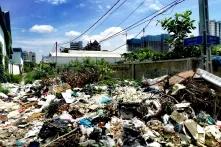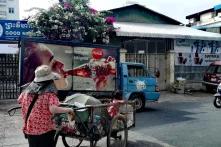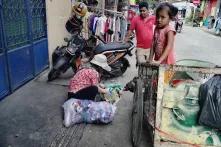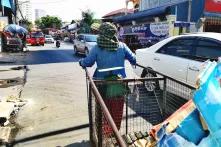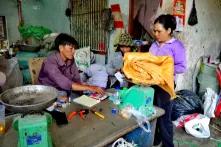Waste is pervasive. Its omnipresence in urban Phnom Penh is undeniable. It’s there. On the streets, in the corners, in the backyards of ownerless properties – in the waste pickers’ pushcarts and the Cintri workers’ hands. Its visibility robs the city’s breath. But its pulse still goes through its vein. The vein which has been erected and hand-built by mainly women waste pickers who constantly collect recyclable waste pieces while looping around the city. These people collect what they find to be sellable and reusable. These people basically make keep the city clean.
The overall situation of waste management in the capital of Cambodia, which produces about approx. 4 million tons per year of waste, is, slightly said, disastrous (Singh et al. 2018). The solid waste company CINTRI Ltd., which has twofold a long-contract and a monopoly when it comes to the collection of solid waste1, mainly from households in the city, often lacks in the service its name claims to provide. Not being able to fulfil its duty to collect everywhere in the city, due to narrow streets, dark roads and fewer workers and cars, the company has been criticized for some time. Additionally, Cintri only gathers household and markets waste, which makes up to over 50 percent of the overall waste generation of the city2, and they do generally not see themselves in the business of also collecting waste from the roads.
The waste, which remains, comes therefore from an unsystematic discharge and collection practice by residents. Concretely: residents don’t know exactly when and how to bring out their waste or Cintri doesn’t show up at all. Further problems are the practices of discarding and dumping waste somewhere but not in the proper bins on the streets3. Eventually, there are two categories of waste regularly left in Phnom Penh’s streets: recyclables and other unwanted, already fragmented pieces of waste.
The daily practice of the ‘ad chais’
Recyclables are collected by mainly women waste pickers, calling themselves ‘ad chais’, and they are omnipresent in the streets, too. There are only blurry numbers of the size of the group available. IGES states in their policy report on organic waste from 2011 that there must be 2,0004 waste pickers, but due to rapid urbanisation trends where more and more citizens are piling into the city, which also generates more waste, it must accordingly be even more. As a societal marginal class, ad chais reclaim their right to the city while walking through “their” streets. Most of them come from rural areas, having headed to the city in the hope of a job and a better life where they’ll be able to pay their children’s school fees and send some money home to their old and weak parents, who are unable to continue working in the fields. Due to their need to sustain their livelihood in the capital more and more, women become ad chais after having already worked as manual labourers on construction sites, as cleaners or “scalers”, a person who carries along a scale for either people or things to be weighted. Unless almost every household owns their own green scale nowadays, this job has literally died out.
When her alarm clock rings, Boupha5 wakes up aware that this will be another long day on the streets. She works mainly in Phnom Penh’s Toul Tom Pong area, where she collects daily recyclables from six to ten. After unloading their collectives to “her” depot, she goes to the market to buy essential foods before returning home to cook and look after her children. After a short break, she continues working until the evening hours. This work is done seven days a week, every single week a year, every month and year. Exceptions are holidays where she drives home to her village, days of illness or when the rain is too heavy to collect rubbish.
“I would pick anything up whether it’s just one bottle or one can, except unusable waste. I only pick up things that can be sold,” Boupha says and points at her already almost full packed cart, where plastic bottles, aluminium cans are mixed up with paper, thin plastic to-go cups, cardboard and hard plastic soy sauce bottles. “But copper is still the most valuable, next to aluminium (…), so these are my favourite kinds of recycling waste,” she adds, and starts laughing.
Due to their collection practices, the ad chais both provide the further distribution and revaluation of recyclable waste and make themselves independent from strict working arrangements they would face working in garment factories, for instance. Moreover, most women consider themselves too old to work at factories: “I don’t know what else to do; it’s my only job. I cannot do any other work excluding being a servant or a factory worker. But that’s not possible because my child is still young and I’m already too old for that kind of work. (…)” or, as another puts it: “It can feed me daily, and it is not so difficult for my strength. It is able to balance my living, and it is not too tiring like doing the construction work. Doing construction work is very tiring.” Working as a waste scavenger provides a daily (not monthly, as in most jobs) salary and has self-organised, independent working hours. At least almost, because the depots close in the evening overnight, too.
Moreover, working in a factory would also mean not being able to take their children with them, if needed. This is definitely something, which they need to do often, especially when children are younger. This might be the case if, for example, the husband can’t take his eye off the rice wine the Tuk Tuk drivers hand over to him. When asked about how she explains her job to her children, one waste-picker said, “My children know; they have been on the cart with me since they were young until they have grown now.”
Their grid of service is basically constructed between themselves and the recyclable waste they find on the streets, but also between them and what they call “regular customers”, meaning households selling directly to waste pickers. So most of the infrastructure of recycling waste is functioning because there is an active bond of reciprocity between households and the ad chais or to Cintri workers, who collect recyclables in addition to their regular job, too. Supply and demand are therefore functioning as a part of the market system as well as infrastructure in providing the service. This provision of the fundamental and essential system has been built bottom-up by the people, and therefore there is a dynamic grid of service and supply spans itself over the whole city. The creation of this service was mainly possible because of the absence of political will for legal regulations and concrete action.
Political breeding ground - or ‘lex absentee’
There are several sub-decrees and laws in Phnom Penh directing solid waste management (SWM). Solid waste per se includes a range of garbage which is discarded as unwanted and seen as useless. The management of this should be an essential and implicit task within sectors of environmental planning and politics. Waste management, therefore, refers to proper and environmental-friendly removal of waste, which includes material recovery, too, as pointed out by Seng et al. Over the last years, there has been a change in Cambodia in which the administrative responsibility on waste management was shifted to sub-political entities, concretely to municipalities and districts across the country. This decentralised endeavour was undermined by the 113 sub-decree on the management of urban garbage and solid waste6 in 2015 in Phnom Penh, which extended the former sub-decree on solid waste management, which was implemented in 19997. But none of the sub-decree contents refer directly to the use and potential reuse of recyclable waste. Hence, the authors of the latest report, which was prepared by leading research think tanks and NGOs on behalf of the UN Environmental Programme on Solid Waste Management in Phnom Penh, suggest in their conclusion that through encouragement and support of waste recycling facilities in Cambodia, a platform for green business units could be provided8.
At the same time, a new strategic plan (2018 – 2035) regarding the overall waste management situation in Phnom Penh has been planned. At the moment, it’s in its final stage and has to be endorsed by the Phnom Penh City Hall. As the IGES (Institute for Global Environmental Strategies) suggests in their 2017 summer policy report, the city government should focus on five action areas, a crucial one of them being to deal with the matter of recyclable waste. The Japanese institute has been involved in consulting and creating the forthcoming strategy report – in conjunction with UNEP, NEXUS, and other consultants as representatives of COMPED, for instance9. The strategy plan foresees what Singh et al. call in their report a holistic approach to waste management, addressing mainly solid waste streams but also recyclable waste management. Even though the report hasn’t yet been finalized, there’s one finalised recommendation to provide breeding grounds for private investors who are willing to erect recycling factories in the country. As most of the collected recyclable waste goes abroad, mainly to China, Vietnam and Thailand, Cambodia has a financially-oriented interest to keep the gold piles recyclables bring into their own country. This also covers recommendations articulated by the IGES where it states that the second research area on recycling should aim to promote the recycling industry.
That the Ministry of the Environment (MoE) aims at this idea, too, was unveiled in the planned construction work of a recycling site in the Svay Rieng province, as announced by Khmer Times in 201610. The Japanese firm, Gomi Recycle 110, aims to recycle especially plastic and bring the renewed products into the local Cambodian market. Further, the Cambodian government announced their desire for private investors at the World Bank’s databank for foreign direct investment. Here, it states, that the government is searching for a foreign company “(…) to own a provider of solid waste collection, disposal and recycling services.”11
While Phnom Penh’s “official” recyclable waste management seems until now to have not been fully planned, a woman already provides this essential infrastructure. This marginalised group of poor women is steeped the sound kaleidoscope of car noises, honking trucks – most of them do not even dare to shout about their services out loud, as Boupha describes herself: “(..) I don’t dare to shout. I get into the habit of squeezing the horn since I started.” Walking at the edgest side of the road implies angry traffic participants are manoeuvring their motobike around waste scavengers and their heavy pushcart, and invectives and abuses by Tuk Tuk drivera at the corner abound. Some laughers here, some others there. Some kids are acting cattily, the sun burns and the baby cries. And sometimes a family gives lunch leftovers to the ad chais with a warm smile. All these things show that ad chais have a hard life, as is expected for the marginalised poor. But what is really “left-over” when one thinks about Phnom Penh is the picture of the colourful looped-clothed waste pickers in the streets. Due to their physical presence in the public sphere, where everybody knows them and their service, they act politically. Without them, nobody would ever think about poor women and other marginalised groups while walking past the glamorous buildings which have been so quickly erected in the last few years. Glimmering golden shadows from a building fall, reflecting the fracture of the squeezed plastic bottle in the cart while Boupha walks by. On her route. In her city.
Gender the infrastructure!
While infrastructure is normally connotated with attributes of masculinity, such as strength and technical aspects, the infrastructure of recyclable waste has discovered a merely female body. Whereas bridges and railways are constructed with heavy material, carried by men and constructed by male architects and engineers, the infrastructure of recycling waste is, as we can see, one which is created and sustained by women. Especially when it comes to the basic work of picking up and selling to depots, women who spend all day long collecting and gathering waste in Phnom Penh’s street are as visible as is the waste itself. With their presence, they not only show that they are in the urban picture of coffee houses, shops and a vast amount of construction sites, but they also force people to consider them in the bigger public picture, that they are a considerable group of female workers who constitute the technical infrastructure which should have been implemented by state responsibilities, but wasn’t
1 Solid waste includes hard objects, hard substances, and products or refuse, which are useless and disposed of (Kingdom of Cambodia. 1999. Sub-Degree on Solid Waste Management. No: 36 ANRK.BK No: 36 ANRK.BK)
2 Singh, Rajeev & Dickella, Premakumara & Yagasa, Ran & Onogawa, Kazunobu. (2018). State of Waste Management in Phnom Penh, Cambodia.
3 IGES 2017- Development of Waste Management Strategy and Action Plan of Phnom Penh, Cambodia. https://www.iges.or.jp/files/research/scp/PDF/20170718/Yagasa.pdf (Accessed on: 11.10.2018).
4 Sang-Arun, Janya et al. (2011). A guide for technology selection and implementation of urban organic waste utilisation projects in Cambodia. IGES: Japan.
5 All names have been changed by the author.
6 The sub-degree differentiates between urban garbage, solid waste, hazardous and industrial waste only. Urban garbage is therefore “(…) referring to tools, equipment, products that were left or created by action and everyday livelihood of human without toxic substance or hazardous waste.” Whereas solid waste directs waste, that “(...) was left or created by business activity or service without toxic substance or hazardous waste.” Kingdom of Cambodia. 2015. Sub-decree on Management of Urban Garbage and Solid Waste. No. 113 NKR.PR
7 Kingdom of Cambodia. 1999. Sub-Degree on Solid Waste Management. No: 36 ANRK.BK No: 36 ANRK.BK
8 IGES, UN. 2018. State of Waste Management in Phnom Penh, Cambodia
9 Singh, Rajeev & Dickella, Premakumara & Yagasa, Ran & ONOGAWA, Kazunobu. (2018). State of Waste Management in Phnom Penh, Cambodia.
10 Kunmakara, May (2016). Plastic Waste to be Put to Good Use, in: Khmer Times, July 21, 2016. https://www.khmertimeskh.com/news/27468/plastic-waste-to-be-put-to-good-use/ .
11 WorldBank (2018). Investing Across Borders. Indicators for Foreign Direct Investment Regulation. http://iab.worldbank.org/Data/ExploreEconomies/cambodia/wastemgmt (Accessed on: 12.10.2018).
